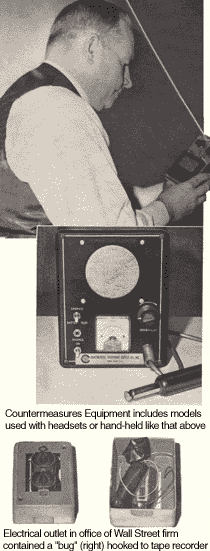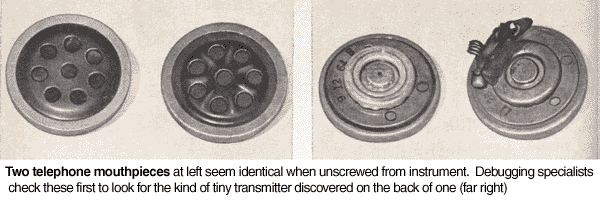
|
WANTED: Electronic Detectives
Locating "bugs" planted by industrial spies can be a profitable business-if you know electronics and like detective work
by Mort Schultz - (Popular Mechanics, January 1971)
The small advertisement tucked away in the Wall Street Journal read:
"Elimination of electronic eavesdropping devices."
That was all, plus, of course, the identification of the company offering the service.
Why would someone offer a service for a problem that had been eliminated by law? The Omnibus Crime Control and Safe Streets Act of 1968 outlaws the use of electronic eavesdropping equipment ("bugs") by other than law enforcement agencies and calls for a stiff fine of $10,000 and a five-year jail term if violated.
Apparently the law hasn't stopped eavesdroppers. This conclusion was verified later by William LaHiff of Sapan Engineering, New York City, the company that had placed the ad.
"Legislation to the contrary, much industrial eavesdropping is going on," he told me. One estimate is that approximately $2 billion a year in secrets is stolen from industry via the electronic bug route. This means that the law has a big bark but no bite.
Electronic bugs are wireless. An eavesdropper can relax and listen over a receiver that looks like a radio in the safety of his car or a nearby room.
In the early days of bugging, microphones were used. The eavesdropper needed time to plant a mike and run its wires to a pickup device, such as a tape recorder. If uncovered, the wires could be traced to the pickup, almost surely leading to identification of the eavesdropper.
|
|
Today's electronic transmitters are tiny and readily concealed. When an eavesdropper gains access to an office on one pretext or another-for example, claiming to be a telephone repairman-he can hide a bug in the phone or in such places as light fixtures, plants, bookcases, rugs, plastic tape dispensers and cigar humidors. Only one transmitter per room is needed. Modern bugs can pick up and transmit normal conversation for a distance of one mile. Companies pay handsomely for someone who can find hidden transmitters. Ben Jamil of Continental Telephone Supply Co., New York City, says his fee is $100 per room.
"When I'm hired on a yearly basis, I get from $3000 to $5000 for sweeping a company clean every two or three months," he claims.
Although the money is attractive, the field isn't overcrowded. Even in the highly industrial Northeast, I found only the two companies mentioned plus one other, Criminal Research Products, Inc., of Conshohocken, Pa., that said it had a debugging service.

If there are more, they aren't talking. A spokesman for one company that once dealt in debugging explained, facetiously I thought, that "since the law makes bugging illegal, there's no need for debuggers."
Richard F. Sirchie, president of Criminal Research Products and a noted authority on bugging, offers a more valid explanation for the apparent scarcity of debuggers:
"Many outfits that once offered a debugging service also sold bugging equipment. This is now illegal, and these companies have gone underground so they can continue in this lucrative business. To avoid attention, they no longer engage in debugging which requires advertising."
  The fact that industry needs debugging specialists was verified by several industrial officials.
The fact that industry needs debugging specialists was verified by several industrial officials.
"Law or not, we can't afford to take the chance that we're not being bugged," a spokesman for an electronics firm told me. "That's why we retain someone to inspect offices and conference rooms."
The companies I asked are those that eavesdroppers consider as prime targets. They are in electronics, textiles, fashions, chemicals, pharmaceuticals, and other businesses that depend upon new ideas and processes for existence.
How does one become a debugger? A background in electronics, especially theory of alternating current, is essential. This gives a basic understanding of how transmitters work.
Sophisticated bugs don't need self-contained batteries for power. One bug I saw not only looks and acts like a telephone transmitter, but uses phone power for its operation.
To plant this bug, the eavesdropper unscrews the phone's mouthpiece, removes the real transmitter and drops the bug into its place. When the receiver is lifted, the bug is activated. The eavesdropper need never worry about a dead battery.
A background in electronics also allows a debugger to save a sizable chunk of cash by providing him with the mechanical knowledge he needs to build his detection equipment. The basic detector used by a debugger operates in the 72 to 108-megacycle range. It costs $175 and can be purchased from most electronic supply houses. However, someone who has the knowledge can build it for less than $20.
A debugging specialist must be patient and meticulous. Bugs do not yield to a haphazard search. Each part of a room must be examined with extreme thoroughness.
Hooshang Eliasi of Continental Telephone, who learned debugging in his native Iran before coming to the United States, told me of a case that demonstrates the need for persistence. It involved a famous pharmaceutical company in New York that had lost several secrets to a competitor.
A two-day search of offices and conference rooms revealed nothing. On the third day, Eliasi examined the executive dining room.
After scanning utensil bins, tables, light fixtures, walls, ceiling and rugs, he was about to leave when he spotted a cigar humidor on a shelf in the back of the room. Opening it, he pointed his detection meter's probe at the cigars and got a reading.
Eliasi proceeded to unwrap each stogie until he found the bug inside the tobacco wrapper of a cigar that was lying on the bottom of the box. Since the humidor was refilled every few days, with new cigars placed on top of those on the bottom, there was little likelihood of someone "smoking" the bug.
To get a feel for how difficult it is to debug a room, I asked a New Jersey private detective agency to give me a brief indoctrination. I started by doing what I had seen on TV. I ran my fingers around picture frames. That exterminated one bug.
The detection meter the detective had loaned me uncovered others. One was taped beneath the desk. Others were found inside a lampshade, in a potted plant, pinned to the drapery and taped to a volume of an encyclopedia. These were all obvious spots that someone looking for bugs would examine.
It took me 20 minutes to find these transmitters, but my self-satisfaction was shattered when the detective said, "There are more."
Two hours later when I finally gave up, the detective hooked the telephone cord around the detector's probe, called the number on another phone and lifted the receiver. The meter showed a reading. The phone was bugged,
I had probed the phone, too, but had simply scanned the case. My method had not simulated calling conditions that activate this bug so I had no indication of a transmitter on my meter.
The detective now walked to a wall. Holding the probe downward so it almost touched the wall, he practically crept along the wall. After several minutes, there was a rise of the meter's needle.
The detective then slowly scanned back and forth until the maximum reading of the needle showed that he had keyed on the bug. It turned out to be the wall outlet; that is, a bug that looks like a wall outlet and allows the person being bugged to use it as such.
Examining the lower part of the wall took the detective a full 10 minutes. "That's how carefully it must be done," he commented.
When a man is ready to start as a debugging specialist, he lets industry know of his availability by advertising in trade journals.
If you wish to read more about debugging, The Electronic Invasion by Robert M. Brown (1967, John F. Rider, New York, publisher) is an excellent source. Brown is a leading authority on electronic transmitters and offers an encouraging word for someone who thinks that debugging affords a potentially good business opportunity.
Brown says that since industrial eavesdroppers don't usually use the extraordinarily sophisticated and very expensive bugs that international espionage agents employ, a good industrial debugger will almost always uncover the bug. Debugging offers a legitimate, possibly lucrative, business opportunity to those who know electronics and like detective work.
|




 The fact that industry needs debugging specialists was verified by several industrial officials.
The fact that industry needs debugging specialists was verified by several industrial officials.
